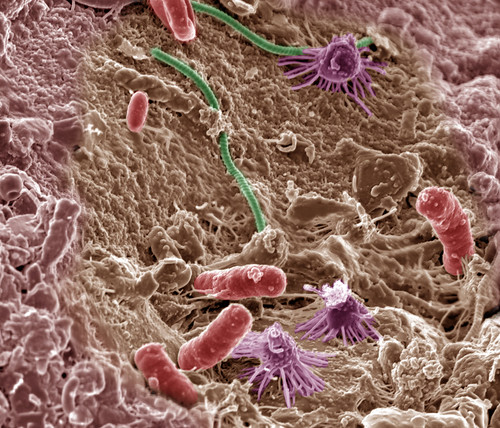Microbes may not be so adaptable to climate change

Microbes in soil — organisms that exert enormous influence over our planet's carbon cycle — may not be as adaptable to climate change as most scientists have presumed, according to a paper published March 2 in PLOS One.
The finding means that a big piece of the puzzle regarding the future climate of our warming planet just got a little tougher to fit into current computer models.
Soil holds an enormous pool of carbon — in a forest, for instance, usually there is more carbon beneath the surface than in the trees above — and what happens to that carbon is an important factor in the future of our planet. Bacteria, fungi and other microbes are central players, converting carbon and other elements in the soil into carbon dioxide and other gases that are expelled into the atmosphere.
"Soil is the major buffer system for environmental changes, and the microbial community is the basis for that resilience. If the microbial community is not as resilient as we had assumed, then it calls into question the resilience of the overall environment to climate change," said author Vanessa Bailey of the Department of Energy's Pacific Northwest National Laboratory.
The findings are based on a unique 17-year study of transplanted soils on a mountain in eastern Washington state. The team moved some samples of soil down the mountainside 500 meters to a warmer, drier climate, and other samples up 500 meters to a cooler, moister climate. After 17 years, they analyzed both sets of soil in the laboratory, as well as "control" samples from both sites that had never been moved.
The scientists analyzed the make-up of the microbial communities, their enzyme activity, and their rates of respiration — how quickly microbes convert carbon in the soil into carbon dioxide which is released to the atmosphere.
The scientists found less adaptability than they expected, even after 17 years. While the microbial make-up of the samples did not change much at all, the microbes in both sets of transplanted soils retained many of the traits they had in their "native" climate, including to a large degree their original rate of respiration.
The message, the authors say, is that scientists can't simply assume that microbes will nimbly respond to climate change.
"The fact that the soils' native environment continued to exert profound influence on microbial activity 17 years later is quite surprising," said co-author Ben Bond-Lamberty, a scientist with the Joint Global Change Research Institute, a partnership between PNNL and the University of Maryland in College Park, Md.
"We can't assume that soils will respond to climate changes in the ways that many scientific models have assumed," Bond-Lamberty added.
In their study, the PNNL scientists took advantage of a mountain location where the climate changes quickly as one moves higher. Just 500 meters up the mountain, temperatures cooled about 5 degrees Celsius on average and rainfall increased about 5 centimeters annually. That translates to more vegetation at the higher location and thus more carbon available to microbial communities.
The microbes native to the higher site respired at a higher rate naturally, due to the moister climate and a more plentiful supply of carbon in their environment; when they were moved to the lower, warmer site, they continued to respire at a faster rate than the surrounding "native" soils and microbes. And the microbes transplanted from lower ground to higher ground had an unusually small response to the temperature change, though biological theory and climate models predict a larger change.
"With our changing climate, all microbes will be experiencing new conditions and more extremes," said Bailey, a soil microbiologist. "Climate change won't translate simply to steady warming everywhere. There will be storm surges, longer droughts; some places may end up experiencing more mild climates. This study gives us a glimpse of how microbes could weather such changes under one set of conditions. They may be constrained in surprising ways."
The study was funded by the Department of Energy Office of Science. Measurements of various forms of carbon were done at EMSL, the Environmental Molecular Sciences Laboratory, a DOE Office of Science user facility at PNNL.
Reference: Ben Bond-Lamberty, Harvey Bolton, Sarah Fansler, Alejandro Heredia-Langner, Chongxuan Liu, Lee Ann McCue, Jeffrey Smith, Vanessa Bailey, Soil respiration and bacterial structure and function after 17 years of a reciprocal soil transplant experiment, PLOS One, March 2, 2016, DOI: 10.1371/journal.pone.0150599.
Legal Disclaimer:
EIN Presswire provides this news content "as is" without warranty of any kind. We do not accept any responsibility or liability for the accuracy, content, images, videos, licenses, completeness, legality, or reliability of the information contained in this article. If you have any complaints or copyright issues related to this article, kindly contact the author above.
